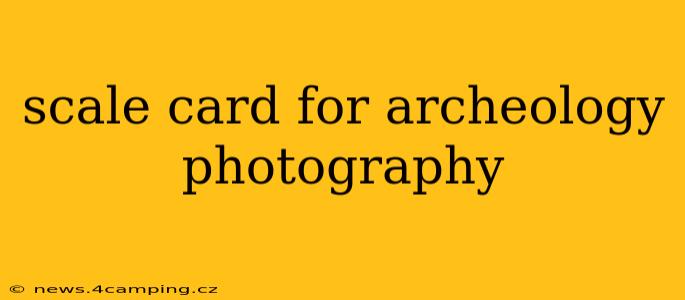Archaeological photography demands precision and accuracy. A crucial element often overlooked is the use of a scale card – a small, flat object with clearly marked measurements used in photographs to provide a visual reference for size and scale. This guide will delve into the importance of scale cards, their types, and best practices for their effective use in archaeological documentation.
Why Use a Scale Card in Archaeology Photography?
A scale card is indispensable for several reasons:
-
Accurate Size Representation: Photographs, especially those taken without context, can be deceptive regarding object size. A scale card provides an objective measure, allowing viewers to accurately assess the dimensions of artifacts and features.
-
Enhanced Context and Detail: By including a scale card, you provide critical context to your photographs. The scale becomes a tangible reference point, helping researchers and viewers understand the size relationship between objects and their surroundings.
-
Scientific Rigor: Archaeological documentation demands the highest standards of accuracy and scientific rigor. The use of a scale card contributes significantly to the validity and reliability of your photographic record.
-
Future Reference: The scale card ensures that the images remain accurate and useful for research and analysis years after they were taken.
Types of Scale Cards
Several types of scale cards are used in archaeology, each with its advantages and disadvantages:
-
Metric Scale Cards: These cards utilize the metric system (centimeters and millimeters), which is the preferred system in many parts of the world and is generally recommended for archaeological work due to its international standard.
-
Imperial Scale Cards: These cards utilize the imperial system (inches and feet). While less commonly preferred internationally, they might be necessary based on specific project requirements or regional preferences.
-
Combined Metric/Imperial Scale Cards: These cards provide measurements in both metric and imperial units, catering to a wider audience and accommodating varied needs.
-
Custom Scale Cards: For specialized projects or research focusing on minute details, custom-made scale cards might be necessary, featuring highly precise graduations or specific markings.
What information should be included on a scale card?
A well-designed scale card should clearly display:
-
Clear and Easily Read Measurements: The markings should be bold, easily distinguishable, and evenly spaced.
-
Units of Measurement (cm, mm, in): Clearly indicate the units used for measurements.
-
Date: The date the photograph was taken should be included, allowing for easy temporal reference.
-
Site Identifier: Include a unique site identifier to aid in organization and cataloging.
-
Artifact or Feature Identifier: If applicable, include a unique identifier for the specific artifact or feature being photographed.
H2: How to use a scale card effectively in archaeological photography?
Effective use of a scale card requires careful planning and execution:
-
Placement: Place the scale card in the photograph alongside the subject, ensuring it is clearly visible and in focus. Avoid obstructing crucial details of the artifact or feature.
-
Lighting: Ensure adequate lighting on the scale card to ensure clear visibility of the markings.
-
Angle: Maintain a consistent angle between the camera and the scale card for accurate measurement representation.
-
Multiple Views: For complex objects or features, use multiple scale cards and multiple photographs from different angles to ensure complete documentation.
-
Material: Use a durable material that is resistant to damage and weathering conditions.
H2: What are the common mistakes to avoid when using a scale card?
-
Obscuring the Subject: Don't let the scale card cover important details of the artifact or feature.
-
Poor Lighting: Insufficient lighting on the scale card will render the measurements unreadable.
-
Incorrect Placement: Placing the scale card too far from the subject will not accurately represent the scale.
-
Unclear Markings: Using a poorly printed scale card with illegible markings will defeat the purpose of using one.
H2: What are some alternatives to physical scale cards?
While physical scale cards are generally preferred, alternatives exist:
-
Scale Bars Added in Post-Processing: Software can add scale bars to photographs after they have been taken. However, this method lacks the precision and reliability of a physical scale card.
-
3D Scanning and Modeling: 3D scanning provides detailed measurements, eliminating the need for scale cards in some instances.
Conclusion
Using a scale card is a fundamental best practice in archaeological photography. By following these guidelines, archaeologists can create accurate, reliable, and contextually rich photographic records for current and future research. The precision provided by a well-placed and clearly visible scale card significantly enhances the value and scientific integrity of archaeological documentation. Remember, a well-documented archaeological site is a well-preserved legacy.
